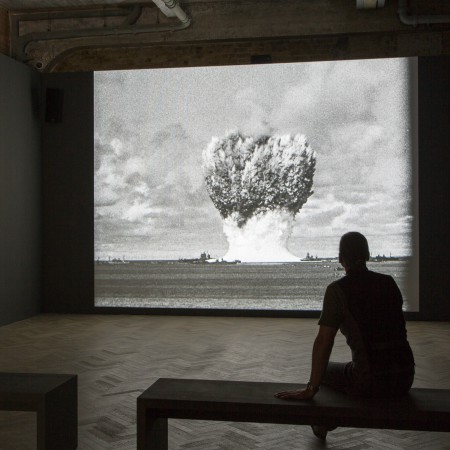I sat and watched Crossroads by Bruce Conner for half an hour. I sat down right in the middle, catching the second half in a fog of psychedelic rock. The smoke from the experiment poured at me, over the camera, and I slowly started to discern a ship, and many, and then it ended before it started again.
From the 1940s, when the footage was recorded, to 1976 when Conner released this piece, to today when I’m about to go Live on Instagram. The capacity to capture and disseminate information has become more and more accessible to these hands. The ability to hear a plurality of perspectives and opinions has become inevitable. But we too often use today’s platforms for disseminating information to disseminate opinion without all of the facts (and sometimes with alternative facts because why not right? The truth is a lie.)
Conner is presenting us something which is happening in an extremely controlled environment, and in a way, Conner has given us an opportunity to reflect on what has changed between the 1940s and 2017. How do we access information about current events? Is plurality of opinion truly better, or are controlled environments and inputs more thoughtful and, thus, informative?
Under the same roof, Allison Saar displays a pelt: skin stretched out, tacked to the wall. Skin/Deep. The piece is at once passive and terrifying: Saar speaks to the skin’s capacity to protect us, but it simultaneously leaves us vulnerable to the world (particularly if the skin is black or brown, as is the case here.) Saar made this in 1993 when, as she says in the audio guide, she “couldn’t watch the television” as coverage of the Rodney King riots and other examples of police brutality against people of color overwhelmed news coverage.

Again, while this work was made decades ago, it nonetheless has more to say today. Saar’s piece evokes the images our screens show us today: of black bodies being murdered, of black bodies lying in the street. Saar’s piece speaks the language of the society from which it comes, a society which sees black bodies as dispensable, or as trophies of white supremacy. But what is a body without its skin? When Saar takes the skin off the individual, she removes their armor and the rest of the person is elsewhere, the contents of this skin are both unimportant and too vast to comprehend.
And the skin isn’t done yet either. Something has left an impression on it: ceiling tins. Suddenly, the body is rippling, and there is life and vitality beneath and within. Ceiling tiles have left an impression on this surface, and this delicate ornamental touch tells us this skin isn’t meant to be hung on the wall, but it comes from the ceiling, it comes from above. That it is here right now is improper. Suddenly there is movement, and again there is life underneath this skin. And we realize this isn’t skin: it’s copper. Copper, which at once could be on the ceiling or underneath floorboards or in our pockets. Copper is everywhere, constantly moving.
In both pieces, comparisons can be drawn between the work and contemporary media. Conner’s piece expands on the concept of the spectacle, focusing on one event and literally viewing it from a plurality of perspectives. Nothing changes about the event, but after a while, the viewer engages with the spectacle differently. Awe at the novelty of seeing an explosion that big is underwhelmed by considering what happens to the ships and people that get caught in the smoke clouds, will the birds and planes get engulfed in the fire, is this really something I want to see? So, too, does news coverage of a presidential speech or a high-profile murder get underwhelmed when speculation is resisted until facts have come in, and the situation can be seen from all sides.
Saar’s work comes from a place of media saturation, and as a result of both this place of origin and systemic racism in America, its message is just as relevant today as it was then, if not moreso. We see an artifact, we just know there is something else to this individual: it is their contents, their muscles, their soul. But we don’t know anything about it, and we can’t. White supremacy has made America a place in which people of color are often seen only as their race, manifesting in racist speech in news media and the murder of people of color by law enforcement. This typified, one-dimensional understanding of the person of color, particularly the black person in America and the media is confronted and combated by Saar’s work, which meets this one-dimensional reading on its own terms and subverts it deftly and successfully, through physical, material, and imaginative means.

No comments:
Post a Comment